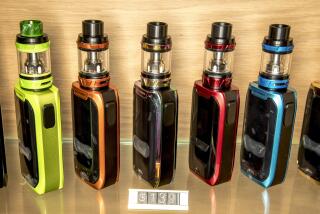FDA to begin regulating e-cigarettes

The FDA plans to impose the first federal regulations on electronic cigarettes, banning sales to minors and requiring manufacturers to put health warnings on the devices.
WASHINGTON — The Food and Drug Administration plans to begin regulating electronic cigarettes for the first time, banning sales to minors and requiring manufacturers to put health warnings on the nicotine-delivering devices that have become a multibillion-dollar industry, according to officials who described the agency’s proposal.
But the agency will stop short of steps that many public health advocates and some members of Congress have called for, including restrictions on television advertisements and flavorings, such as pumpkin spice or chocolate, that may target younger consumers, officials said. The agency plans to announce the new rule Thursday.
Regulators do not yet have scientific evidence for a rule on flavorings, but the subject is still being researched, Mitchell Zeller, director of the FDA’s Center for Tobacco Products, told reporters.
“There are far more questions than answers,” he said, adding that the new regulation would provide a “framework” for additional rules in the future.
Even without restrictions on advertising or flavorings, the new rule represents a “significant step in the agency’s ability to regulate tobacco products,” Zeller said. “I call the market for e-cigarettes the wild, wild West in the absence of regulations.”
The proposed rule, which must go through a public comment process and overcome potential legal challenges before becoming final, would impose restrictions on other tobacco-related products as well, including nicotine gels and pipe tobacco.
Companies would have to register the products and their ingredients with the FDA, but would have two years to do so.
In the interim, they could continue selling their existing devices and introduce new products without regulators’ approval. The new health warning labels would caution users against the danger of becoming addicted to nicotine.
E-cigarettes come in several forms, but all heat liquid nicotine into a vapor that can be inhaled and that gives use of the devices its popular term, “vaping.”
The FDA has been trying to regulate the devices for at least five years. In 2009, the agency sought to impose restrictions on them as medical devices designed to deliver nicotine, a chemical compound that is addictive.
After a federal court struck down that effort the next year, the agency switched grounds and declared that it could issue rules for the devices under the authority Congress gave it to regulate tobacco products.
Regulating the devices raises more complex issues than rules for traditional cigarettes because the health impact of e-cigarettes is unclear.
Supporters say they could be beneficial by allowing users to get nicotine without the exposure to tar and other carcinogens found in cigarette smoke. They have touted the devices as an effective way for some of the country’s roughly 42 million smokers to quit.
Opponents say that the devices inevitably will lead to more nicotine addiction, that the health risks of long-term use are unknown and that widespread use of e-cigarettes, especially by minors, will lead to increases in smoking.
“Definitive data” on the health impact of vaping do not exist, an FDA official, Priscilla Callahan-Lyon, wrote recently in a medical journal in which she reviewed studies of the devices.
The agency spent years amassing data before declaring in the mid-1990s that nicotine in the amounts delivered by cigarettes was an addictive drug.
While the debate over the health effects of vaping has continued, sales of the devices have rocketed, reaching more than $1.5 billion in 2012.
A September 2013 study by the Centers for Disease Control and Prevention found the percentage of high school students who had tried e-cigarettes had more than doubled within a year, from 4.7% in 2011 to 10% in 2012.
The growth in use of e-cigarettes has caused some cities, including Los Angeles, Chicago and New York, to ban or restrict their use in parks, workplaces and other public places. More than half the states already ban sales to minors.
In addition to concern about the effect on users, opponents of the devices have warned about secondary risks, particularly from the liquid nicotine that consumers can buy to refill some devices.
In the last few years, poison centers across the country have reported a sharp increase in nicotine poisoning, particularly of small children. Even small amounts of nicotine can cause nausea and vomiting if swallowed by an adult, and can be potentially deadly for a small child.
The CDC reported this month that calls had increased from just one in September 2010 to 215 this February, with more than half of the calls involving children under 5.
A group of Democrats in Congress, including Rep. Henry A. Waxman (D-Beverly Hills) and Sen. Richard J. Durbin (D-Ill.), released a report this month that accused the makers of e-cigarettes of aggressively targeting minors with marketing tactics that would be illegal if used for traditional cigarettes.
The report singled out kid-friendly flavorings, which are banned by law for traditional cigarettes, and the sponsorship of popular entertainment events such as the Coachella Valley Music and Arts Festival.
“With over a million youth now using e-cigarettes, FDA needs to act without further delay to stop the companies from marketing their addictive products to children,” said Waxman, who has led efforts in Congress for decades to limit tobacco use.
More to Read
Start your day right
Sign up for Essential California for news, features and recommendations from the L.A. Times and beyond in your inbox six days a week.
You may occasionally receive promotional content from the Los Angeles Times.






